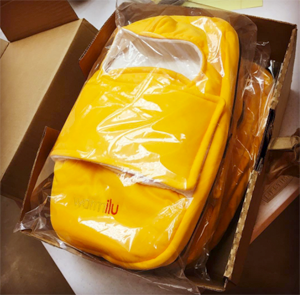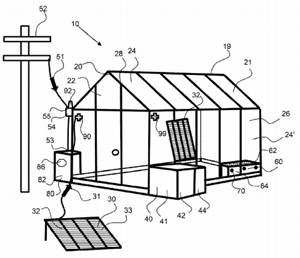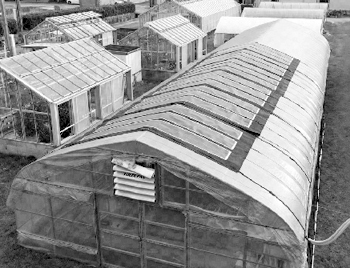 The Phase Change Matters e-mail newsletter is a weekly summary of the latest news and research on phase change materials and thermal energy storage. To subscribe, visit www.puretemp.com/subscribe. For more frequent updates, follow @puretemp on Twitter or visit the Phase Change Matters blog, www.puretemp.com/pcmatters.
The Phase Change Matters e-mail newsletter is a weekly summary of the latest news and research on phase change materials and thermal energy storage. To subscribe, visit www.puretemp.com/subscribe. For more frequent updates, follow @puretemp on Twitter or visit the Phase Change Matters blog, www.puretemp.com/pcmatters.
MEDICAL
PCM-powered infant blankets are headed to Kenya for testing
Grace Hsia, co-founder and CEO of Warmilu LLC, reports that her Michigan startup shipped three infant warming blankets to Kenya this week for regulatory review.
 The IncuBlanket, designed to help preterm infants born in remote parts of developing countries, will undergo testing by Kenya’s Pharmacy and Poisons Board. Once approval is granted, the nonprofit Relief for Africa Foundation, based in Ann Arbor and Nairobi, plans to distribute between 2,500 and 5,000 IncuBlankets throughout the East African nation. Hsia says Warmilu is close to signing distribution agreements with two other medical device distributors.
The IncuBlanket, designed to help preterm infants born in remote parts of developing countries, will undergo testing by Kenya’s Pharmacy and Poisons Board. Once approval is granted, the nonprofit Relief for Africa Foundation, based in Ann Arbor and Nairobi, plans to distribute between 2,500 and 5,000 IncuBlankets throughout the East African nation. Hsia says Warmilu is close to signing distribution agreements with two other medical device distributors.
The IncuBlanket, which has been successfully tested in clinical trials in India, uses packs filled with sodium acetate trihydrate to keep infants warm for up to five hours.
Warmilu recently moved from a small incubator space into a 2,000-square-foot production facility in Ann Arbor.
“It has been just an amazing dream come true, opening this space up and being able to cut and sew our IncuBlankets here,” said Hsia, whose company now has six employees. “[We will] be able by March to make all of our InstaWarmer packs here.”
PATENTS
Enclosure temperature control system
U.S. patent application 20170013789 (applicant Sustainable Energy & Agriculture Technology, Sahuarita, Ariz.):
 “An enclosure temperature control system utilizes a renewable power source and a thermal sink to reduce the overall power requirements from a power grid. A renewable power source, such as a solar panel may provide power that drives the components required to maintain the greenhouse temperature within upper and lower limits, including a HVAC system and/or a heat transfer system coupled with a thermal sink. The thermal sink includes a phase change material that releases heat when it solidifies and this heat can be used to heat the greenhouse. Likewise, the phase change material absorbs heat during the day to reduce the temperature within the greenhouse. A heat transfer system may be coupled with the phase change material and a solid conductor component within the tank of a phase change material may increase thermal transfer rate.”
“An enclosure temperature control system utilizes a renewable power source and a thermal sink to reduce the overall power requirements from a power grid. A renewable power source, such as a solar panel may provide power that drives the components required to maintain the greenhouse temperature within upper and lower limits, including a HVAC system and/or a heat transfer system coupled with a thermal sink. The thermal sink includes a phase change material that releases heat when it solidifies and this heat can be used to heat the greenhouse. Likewise, the phase change material absorbs heat during the day to reduce the temperature within the greenhouse. A heat transfer system may be coupled with the phase change material and a solid conductor component within the tank of a phase change material may increase thermal transfer rate.”
I contacted the inventor, Ashoke Bose, founder of Sustainable Energy & Agriculture Technology, and asked for comment on the patent. His response:
“Thank you for reaching out to me and sharing my patent application with your readers. We at SEAT, LLC are working on the Near Zero Carbon (NZC) greenhouse technology; and this is one of many possible applications of the patent. As far as the background of this innovation is concerned, it is the rising energy cost for heating/cooling of the greenhouse. We are looking for strategic investors/partners for commercialization of the patent.”
Cooling agent for cold packs and food and beverage containers
U.S. patent application 20170016664 (applicant Frosty Cold LLC, Overland Park, Kansas):
“Safe, stable, non-toxic and recyclable cooling agent compositions comprising solid particulate compounds undergo an endothermic process when mixed with water such that the resulting mixture is useful for cooling surfaces, liquids and solids. The mixtures include ammonium nitrate in an amount of at least 45 wt % of the mixture. Total nitrogen—containing salts exclusive of phosphates are present in an amount less than 68% by weight of the composition. A phosphate salt is also present in an amount as needed to stabilize the composition against detonation. A balance of additional salts is formulated to provide the mixture with a cooling capacity of at least 240 kJ/kg of the mixture.”
Devices, systems and kits for regulating skin temperature for mammals
U.S. patent application 20170014266 (applicant Slumber Science LLC, Sunnyvale, Calif.):
“A heat transfer system may include a heat transfer machine adapted to thermally couple to an heat transfer pack housed within an heat transfer device and transfer heat from the heat transfer pack using a power supply. The heat transfer device may include a housing and a heat transfer pack. The heat transfer pack may be adapted to thermally couple to the heat transfer machine, transfer heat to the heat transfer machine while thermally coupled to the heat transfer machine, and transfer heat from a mammal’s skin when the heat transfer device is in contact with the mammal’s skin and uncoupled from the heat transfer machine. … The heat transfer pack may include one or more phase change materials.”
ARPA-E
Technology Showcase lineup set for next month’s Energy Innovation Summit
The 2017 Energy Innovation Summit will be held Feb. 27-March 1 in Washington, D.C. The Technology Showcase highlights the work of recent ARPA-E awardees and a select group of other companies and research organizations. Showcase participants include Electric Power Research Institute (“Indirect Dry Cooling Using Recirculating Encapsulated Phase-Change Materials”); General Electric (“Electrothermal Energy Storage With A Multiphase Transcritical CO2 Cycle”), the University of Cincinnati (“Enhanced Air-Cooling System With Optimized Asynchronously-Cooled Thermal Energy Storage”); Outlast Technologies (“Li-ion Battery Thermal Management using LHS Materials”); and Advanced Cooling Technologies (“Heat-Pipe PCM Based Cool Storage for ACC Systems”).
IN BRIEF
• Stanford University‘s new Central Energy Facility, the heart of a campus-wide energy system, has won a 2017 Institute Honor Award, the American Institute of Architects‘ highest recognition for design excellence. A 2.5-million-gallon hot water tank in the courtyard showcases the energy plant’s mission.
 • A strawberry-cultivation system that stores excess solar heat in a tank filled with cobblestones reduced heating costs by 80 percent at a greenhouse in Japan’s Yamaguchi Prefecture. “A mat-like heat-insulating material” – phase change material, perhaps? – atop the greenhouse, right, is rolled up during the day to let in sunlight.
• A strawberry-cultivation system that stores excess solar heat in a tank filled with cobblestones reduced heating costs by 80 percent at a greenhouse in Japan’s Yamaguchi Prefecture. “A mat-like heat-insulating material” – phase change material, perhaps? – atop the greenhouse, right, is rolled up during the day to let in sunlight.
• A power plant under construction in Kiel, Germany, will be able to store more than 1,500 megawatt hours of heat in a 60-meter-high water tank, ensuring the supply of more than 70,000 district heating customers for up to eight hours. The gas-fired Stadtwerke Kiel will simultaneously generate electricity and heat through cogeneration.
• New from QYResearch: “Europe Bio-Based Phase Change Materials Market Report 2017” and “Global Bio-Based Phase Change Materials Market Professional Survey Report 2017.”
• The Industrial Fabrics Association International has issued a call for presenters for the IFAI Advanced Textiles Conference, to be held Sept. 26-29 in New Orleans. The deadline for submitting a proposal is Feb. 5.
• In partnership with Technical University Hamburg Harburg and Hamburg Energie, Siemens AG is developing a thermal storage system that will convert excess wind energy to heat and store it in rock fill. A steam turbine will convert the heat energy back to electricity on demand. The full-size system will be able to store about 36 MWh of energy in a container filled with 2,000 cubic meters of rock.
• The global market for thermal energy storage is projected to reach a value of $1.8 billion by 2020, Transparency Market Research reports. Latent heat and thermochemical storage technologies are expected to grab market share from sensible heat technology, which is now the dominant technology in the market.
• Pluss Advanced Technologies has an opening for a quality assurance manager at its facility in Bawal, India. The quality manager is responsible for overall development, implementation and maintenance of the quality management system for the company’s polymer and PCM business units.
RESEARCH ROUNDUP
For our full list of recent academic research, see puretemp.com/academic. Here are highlights from the past week:
From Applied Energy:• Preparation and characterization of nano-sized phase change emulsions as thermal energy storage and transport media
From Chemical Engineering Journal:
• Largely enhanced thermal conductivity of poly (ethylene glycol)/ boron nitride composite phase change materials for solar-thermal-electric energy conversion and storage with very low content of graphene nanoplatelets
From Applied Thermal Engineering:
• Analysis of the thermal performance of flat plate PCM heat exchangers for heating systems
From Energy and Buildings:
• Numerical investigation of a triplex tube heat exchanger with phase change material: Simultaneous charging and discharging
• Preparation and properties of fatty acid eutectics/expanded perlite and expanded vermiculite shape-stabilized materials for thermal energy storage in buildings
From Renewable Energy:
• Effect of an increased thermal contact resistance in a salt PCM-graphite foam composite TES system
From Energy:
• Experimental investigation on potential of a concentrated photovoltaic-thermoelectric system with phase change materials
From Chemical Physics Letters:
• PEG encapsulated by porous triamide-linked polymers as support for solid-liquid phase change materials for energy storage
From Renewable and Sustainable Energy Review:
• Morphological characterization and applications of phase change materials in thermal energy storage: A review
From Energy Conversion and Management:
• Preparation and thermal properties of short carbon fibers/erythritol phase change materials
From International Journal of Scientific Research in Science, Engineering and Technology:
• Thermoregulation in Thermo-regulating Fabric: An Overview [pdf]
NETWORKING
Connect with PCM experts and industry leaders on LinkedIn
More than a thousand of your peers have joined a LinkedIn group devoted to the discussion of phase change material and thermal energy storage. The Phase Change Matters group is an interactive complement to the award-winning blog and newsletter of the same name.
 You are invited to join the group and connect with PCM and TES experts from around the world. New members include Jordi Martin Montal, mechanical laboratories test leader at Applus+, Barcelona, Spain; Puneet Kamboj, research analyst at KAPSARC, Saudi Arabia; Wolfgang Göbel, life science account manager at Ecocool, Germany; and Ahmed Aljehani, Ph.D. candidate, University of Illinois at Chicago.
You are invited to join the group and connect with PCM and TES experts from around the world. New members include Jordi Martin Montal, mechanical laboratories test leader at Applus+, Barcelona, Spain; Puneet Kamboj, research analyst at KAPSARC, Saudi Arabia; Wolfgang Göbel, life science account manager at Ecocool, Germany; and Ahmed Aljehani, Ph.D. candidate, University of Illinois at Chicago.